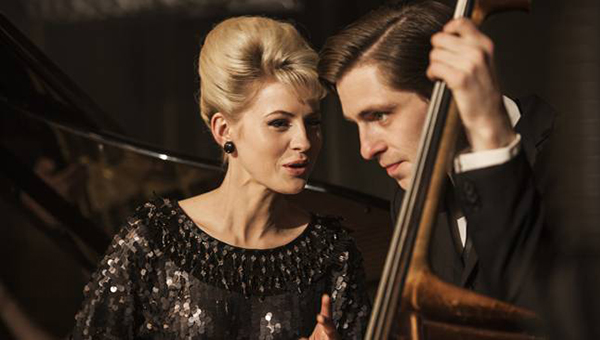A good-looking, if by-the-numbers, biopic of Sweden’s first lady of jazz, buoyed up by an eye- and ear-catching lead performance.
Sweden, the early 1960s: Monica Zetterlund (Edda Magnason) divides her time between working as a telephone receptionist in her hometown of Hagfors and singing American standards with a touring jazz band. Though still young, she already has a child, Eva-Lena, who during her frequent absences on tour is looked after by Monica’s own parents – her mother quietly supportive of her lifestyle, her father insistently unsympathetic. After an opportunity to perform in New York goes disastrously wrong, Monica moves to Stockholm to sing full-time and, with the support of the band’s new bassist Sture (Sverrir Gudnason), experiments with singing jazz songs in Swedish. This is an immediate hit, and Monica quickly becomes involved with many of the leading lights of Stockholm’s cultural scene. Despite her success and new-found wealth, however, Monica finds it difficult to quell her personal demons, putting her personal and professional happiness at risk…
It is unlikely that a late phone conversation between Monica and her father will fail to strike a strong emotional chord with the audience.
If some of the summary above sounds familiar, that should hardly come as a surprise: as the biography of a talented but self-destructive female performer, MONICA Z has more than a few antecedents, but director Per Fly seems content to offer only the slightest of variations on this very traditional theme. What differences there are come from the 1960s Swedish setting and the sheer charisma of lead actor Edda Magnason. Otherwise, we have the usual playlist: humble beginnings; family obstacles; early successes; unsuitable men; drink and drugs; professional setbacks; personal disasters; a kind of redemption. There are also the obligatory montage scenes to show the passage of time. Any reported inaccuracies in the film – which claims to be ‘freely’ based on Zetterlund’s life – are another commonplace of the genre, but in any case may not be picked up by UK audiences.
This well-worn structure has its own pleasures, of course: it is unlikely, for instance, that a late phone conversation between Monica and her father (Kjell Bergqvist), an embittered former trumpet player and her main antagonist throughout the film, will fail to strike a strong emotional chord with the audience. And even in the darkest and most hopeless moments of the film, there is at least the chance to recall, almost nostalgically, its earlier, optimistic scenes, not least because those were so vividly rendered. Indeed, the film’s historical recreations are something of a triumph: the times are beautifully, and apparently effortlessly, brought to life by vintage vehicles, old shop fascias, elegant interiors and above all the period outfits – even if, in accordance with the Mad Men template, the men wear their hats at least one size too small. The film benefits from its combination of two current fashion favourites: Scandinavian design and the early sixties.
At the heart of the musical performances, as with the rest of the film, is Edda Magnason as Monica.
Another plus, naturally enough, is the music: the performances are occasionally a little abbreviated, and occasionally punctuated by random shots of rapt audiences (another cliché Fly fails to avoid), but remain hugely enjoyable. At the heart of these, as with the rest of the film, is Edda Magnason as Monica. Magnason’s background as a jazz musician means that her singing, though reportedly a fine match for Zetterlund’s smoky vocals, can be savoured purely on its own terms. A strikingly beautiful and elegant blonde – after her New York nightclub sessions are prematurely curtailed by racist audiences objecting to her sharing the stage with black instrumentalists, the nightclub owner complains, ‘I didn’t realise she’d be so white!’ – Magnason’s Monica is an expertly realised creation, albeit within the film’s conventional confines. Fly should be given due credit for helping to pace this performance so well, as Magnason shifts from playful to wilful and from individualistic to egocentric with ease, building seamlessly from the brazen and witty young woman at the beginning to become a drunken, attention-seeking monster who almost throws her life away.
In one of the very last shots of the film, as Monica passes through a crowd of well-wishers, Fly allows himself a rest from the film’s studied naturalism to show the clothes of the crowd subtly alter with the change of decades, from early to late Sixties, through the Seventies and into the Eighties – perhaps to indicate Zetterlund’s enduring popularity as a singer and icon. Although the film remains solidly entertaining throughout, this moment of imaginative recreation suggests the possibility that it could have been so much more.
httpvh://www.youtube.com/watch?v=xNqP4B1Ba_A


